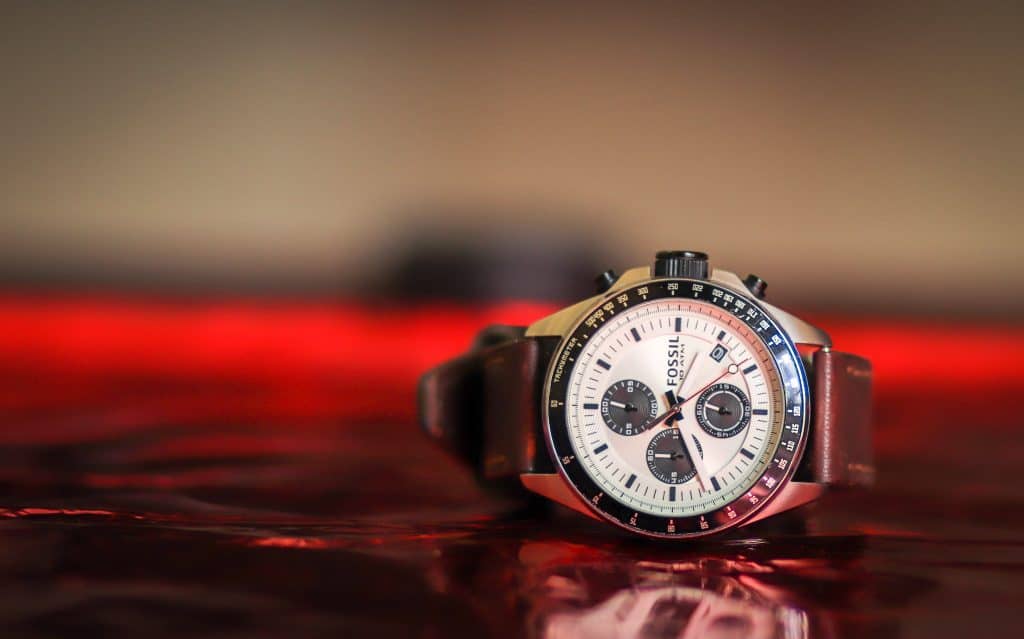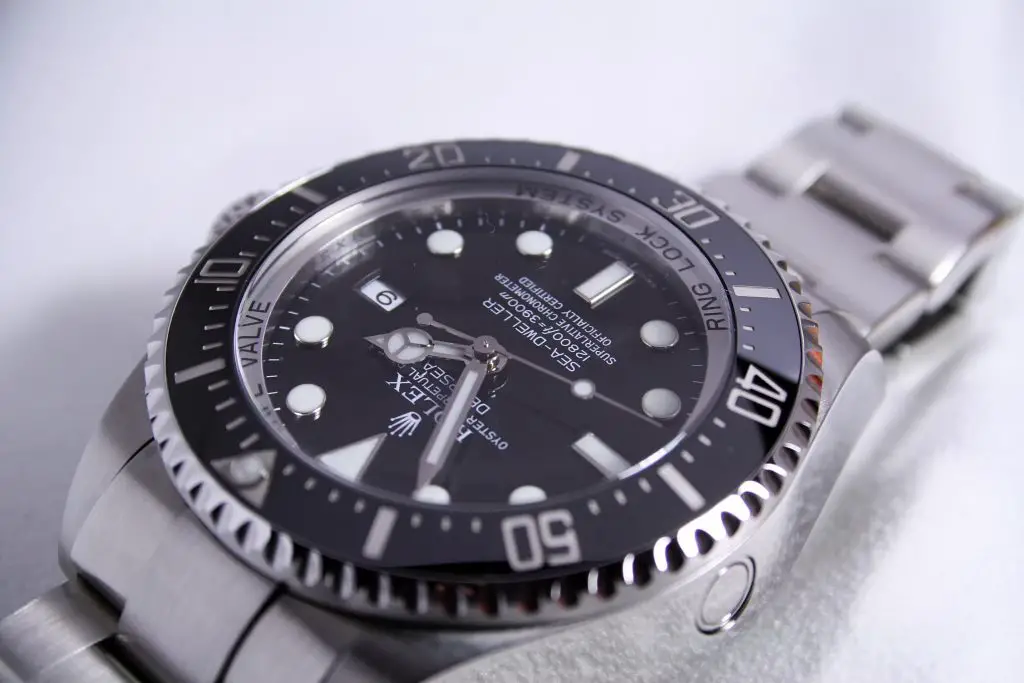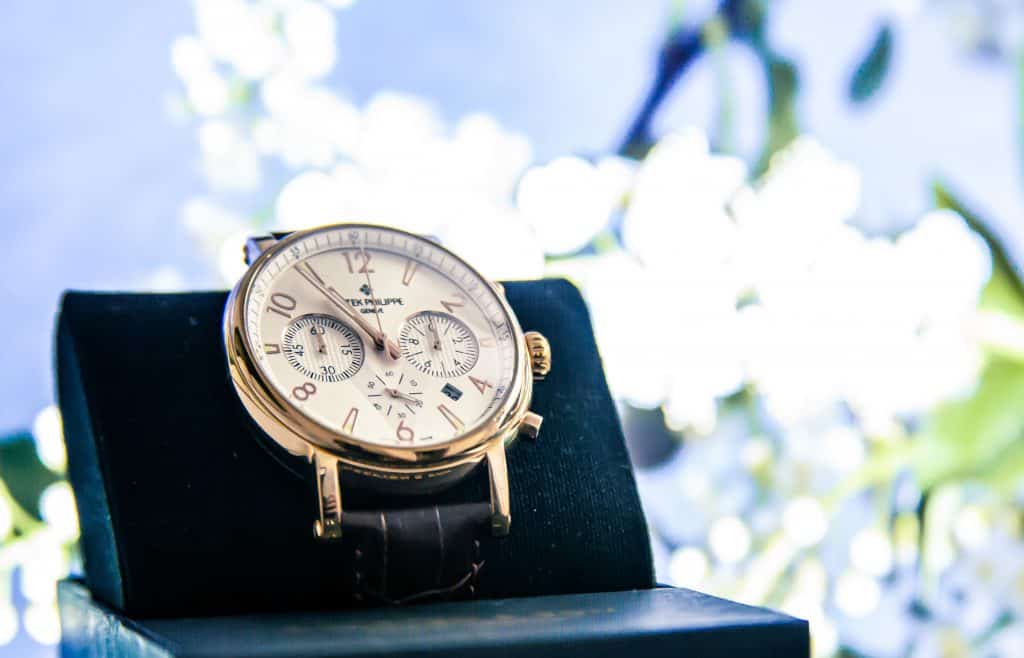
There are so many watch types, makes, and models that it can be challenging to know when you should take your watch in for servicing.
On average, it’s best to take your watch in for servicing every five to seven years. The time frame varies depending on the brand of your watch, its age, and the type of movement inside – whether your wristwatch has manual, automatic, or quartz movement.
To bring you some answers and help you feel more confident about knowing when to take in your precious timepieces for some upkeep – we’ve put together a complete guide on when you should service a watch. We’ll talk about servicing specifics for each type of watch movement – including kinetic watches – and go over potential problems that could warrant more trips to your local jeweler. We’ll also go over a few things to check for to see if your watch needs servicing.
Table of Contents
When Should You Service A Watch
It’s best to service a watch every five to seven years, especially if you wear your watch frequently. Several signs indicate a watch needs some maintenance – like loud ticking and jittery hand movements – but the age of the watch, the type of movement, and the brand that made it also affects when you should take your watch in for some service.
So let’s talk about those telltale signs first, and then we’ll discuss how your watch’s age and brand name affect its suggested service interval.
The Second Hand Skips Or Has Jerky Movement
When you notice your watch skipping a second or two, that is a watch’s way of telling you that the battery needs to be replaced. In quartz watches, this is called an end-of-life indicator (EOL). This is a power-saving feature that most watches have. Some watches may continue to keep accurate time even when the second hand starts skipping. Interesting, right?
Now you can stop wondering if something else happened to your watch – like getting moisture trapped inside or rusting parts – to cause it to skip a beat or two.
But what if the second hand on your watch has jerking movement, like it bumps back or forward? This could be an indication that you have more intricate mechanical problems than a simple battery replacement. We recommended you bring your watch in to have it serviced.
Your Watch Is Fast Or Slow

Several reasons cause your watch to run too fast or too slow and thus need servicing. Different reasons for this could be due to the internal watch parts wearing down, being impacted by the wearer’s movement, the lubrication dried up, or the watch movement being magnetized – most commonly meaning that the watch’s balance spring is becoming stuck to itself.
According to the Offical Swiss Chronometer Testing Institute, watches have a margin of error typically up to six seconds fast or four seconds slow. However, some watches, such as Rolex, have a tighter margin of no more or less than two seconds.
You Hear Funny Noises Coming From The Watch
If you hear a strange or unusual sound coming from your watch, that’s a good sign that it needs to be taken into a watch professional. This could indicate that a screw or spring is somewhere it shouldn’t be.
Tap your watch against the palm of your hand. Do you hear:
- Rattling or clunking?
- A loose part or object moving around inside?
If you do, we recommend that you get your timepiece serviced.
The Hands Or Dial Seem Loose
A loose dial or set of watch hands may point to a future service session. Loose hands on a watch are likely from a nut coming undone that holds the hands in place; it’ll need to be tightened to fix it. A loose dial may indicate that some decorative pieces need some TLC – like the bezels at the edge of a watch dial or the crown.
If your watch crown becomes hard to adjust, the stem inside the watch movement may have broken or gotten stuck. Again, it’s best to take it into a professional then try to DIY for this.
There’s Moisture Inside The Case
Moisture inside the case indicates that either your watch’s gaskets wore out or that they were not properly resealed. You’ll know that moisture is inside your watch case if you see water droplets or condensation underneath the glass part.
No matter your watch’s age, type, or brand, these are proven signs that something in your watch is a little “off.”
You Have An Older Watch
Regarding age, older watches will need more frequent check-ups than newer ones, just like a car (or pretty much anything else!). Parts get worn down, batteries need to be replaced, and eventually, some dirt and grime may work their way inside the case and face. And thanks to evolving technology, brands across the world have upped their game in the manufacturing process. Mega watch companies like Omega and Rolex have higher-quality watches today than they did 20 years ago.
If you want to prolong the time between watch servicings, add investment pieces to your collection from high-quality watch brands such as Patek Philippe, Rolex, and Omega.
So how often should you service a watch? Let’s break it down by watch movement.
How Often Should You Service A Watch

In general, every five to seven years, a watch needs to be serviced. This can differ depending on the type of movement the watch has. Let’s take a look at how often you should service a watch. We’ll go over mechanical (manual and automatic) watches as well as quartz, kinetic, and vintage watches.
Mechanical – Manual Movement
Mechanical watches with manual movement should be serviced every five to seven years.
If your watch is on the newer side, it likely does not need to be serviced as often as older mechanical watches because today’s timepieces are built with parts that can better withstand the wear and tear from constant friction. Ceramic ball bearings and silicon parts such as the oscillator and hairspring are examples of this.
However, if your watch leans towards older – say over ten years – getting it service at least every five years is a good idea.
Mechanical – Automatic Movement
Mechanical watches with automatic movement should be serviced every five to seven years.
Like mechanical watches with manual movement, automatic mechanical watches must be serviced to keep the 180+ components working correctly. The rotor must be lubricated, and any parts that are worn out will be swapped for fresh ones that can take on the day-to-day wear and tear.
Quartz
Quartz watches can be serviced about every ten years. This type of watch is said to be generally maintenance-free because only the battery needs replacing.
Quartz watches require far less maintenance than mechanical watches as they also do not feature as many moving parts, which creates internal friction.
Kinetic
A kinetic watch can be serviced about every ten years. Because kinetic watches work by combining a quartz timing mechanism and self-winding movement (like an automatic watch), kinetic watches can go between servicings for far longer than mechanical, automatic, or quartz watches.
If the watch is left unworn for long periods of time, the rechargeable capacitor loses power. Without movement, power can’t be restored. (We recommend using a watch winder if you have this issue!)
On a side note, it’s best to take it in for servicing every two to four years if you have a vintage watch. Older watches have more fragile, worn-out components, so keeping your watch in good condition further prolongs its life. Watches produced before 1985 are typically considered vintage.
What Does It Mean To Service A Watch

No matter the type of movement a watch has – or even the brand – it will need to be serviced eventually. But what does it mean to get a watch serviced? What happens in the process?
When a watch is serviced, it will be disassembled, cleaned, lubricated, and polished. If there are damaged or broken parts, they’ll be fixed or swapped out for new ones. A watchmaker will then put the timepiece back together, adjust it, then test it for accuracy.
Remember, that like a car, the components of any watch will need to be maintained. The oil that lubricates the internal workings of your watch inevitably gets dry as time goes on; plus, when one part of your watch is damaged, it can damage other parts too.
What Factors Affect How Often A Watch Should Be Serviced
Several factors influence how often you should service your watch, namely, the conditions you wear it in (i.e., to the office or while running or swimming), whether or not it’s keeping perfect time, how you store it, and the brand you bought your watch from.
How You Wear Your Watch
For one, how you wear your watch and where you wear your watch are two important factors in knowing how frequently you should be taking your timepieces in for some R&R. If you regularly wear your watch while exercising – or doing any other activity that involves intense movement, your watch may be more susceptible to breaking and may require less time between servicing. More movement equals more wear and tear and friction on the internal workings of your watch.
Because swimming and diving watches are frequently exposed to water, these kinds of watches will often require more servicing than mechanical or quartz watches. To be water-resistant, swimming watches have gaskets made from rubber or plastic, but they can get dry after five years or so, so it’s best to keep up with the maintenance of your watch.
The Brand Your Watch Is From
However, you may be able to go further between servicings depending on the watch brand you have. The more complications a watch has (complications meaning features on a watch that “complicate” the process of making it) – think wrist pieces with date windows, subsidiary dials, chronographs, moon phases, perpetual calendars, minute readers, and tourbillons, the more often you’ll need to have it serviced.
All these complications complicate the workings of a watch, and they require more parts to function. The more parts and functions, the more risk you run of one of these many parts breaking.
Luckily, most watches with lots of complications are made by the best watch brands out there, so they won’t break easily, but it’s best to have them checked more regurarly.
How You Store Your Watch
Where you keep your watches can affect how often they need to be serviced, especially if the watch requires movement of the wearer or regular winding to keep time.
If you are not wearing your watches regularly or forget to wind or wear them every once in a while, you may want to consider getting a watch winder.
I’ve also written several posts on watch winders, so I recommend checking those out!
Your Watch Isn’t Keeping Time
If your watch isn’t keeping time, that’s an obvious sign that it should be taken into a watchmaker.
Though they seem like an amazing feat of mechanical engineering, watches aren’t perfect, and they do lose time. Mechanical watches may actually lose a few seconds every day!
You’ll notice your watch malfunctioning if the minute hand slightly bumps backward before moving forward or if the hands are moving faster. This means the gears could be worn down or slipping, so it’s best to take it to a trusted professional so they can dismantle your watch, lube it up, fix anything if needed, and put it right back together as good as new.
You could also hear something “off” inside your watch as an indication of a possible problem.
Of course, always check first if it’s the battery. You’ll see that the watch hands won’t move at all. That’s a reasonably easy (and much less expensive!) fix than an entire service session.
Do More Complications Require More Servicing?

The more complications your watch has, the more likely it will need to be serviced. Extra complications require extra parts, and they make the overall watch more complicated. The more complicated a watch, the more you’ll need to service it.
A watch complication is a function on a watch that does something other than telling time. These complications make the watch more “complicated” for someone to work on (thus adding value to the watch).
Examples of watch complications include alarms, calendars, tachymeters, chronographs, and moonphases, to name a few. The date display is the most popular watch complication.
With more complications come more internal working parts. When one part starts to break down, it creates an avalanche effect inside the watch. If you decide to get a watch with multiple complications, be sure you are willing to invest in the time and money needed to get it properly serviced every five to seven years.
Do Certain Brands Require More Servicing?
Brands that make watches with more complications will need more servicing than less feature-heavy brands. The more parts there are, the more chances there are for something to break.
That is not to say avoid watches that boast complications (as that’s what makes so many watches so amazing to wear!), but do keep that in mind when investing in your next watch purchase.
Patek Philippe, for example, has centuries of experience fixing their watches, plus they can also guarantee reliable sources for parts. More modern companies do not have this same proven stability, level of know-how, or substantial connection to source materials.
How Long Does It Take To Service A Watch?

It generally takes four weeks for a company to complete a watch service, though some may take as long as six months. If you send your watch via mail, you can expect the servicing to take a few months. Additionally, the more complications, the longer it will take.
Expect to be without your watch longer if it has many complications.
How To Tell If A Watch Needs Servicing
There are a few quick ways you can check your watch to see if it’s time to take it in.
Let’s take a look at these five signs that signal it’s time to service your watch:
- The second hand skips a few seconds or appears jittery or jerky
- The watch is fast or slow for more than 4-6 seconds every day
- You hear a funny noise – like rattling – inside the case
- The hands or dial appear loose
- There is moisture in the case
Why Should I Service My Watch?
A watch is an investment. It should bring you joy and confidence. If it’s an heirloom, you likely cherish your watch deeply. Why wouldn’t you want to take care of something so special, so near and dear to your heart?
Emotions aside, while servicing a watch is what’s needed to fix something that’s broken, keeping up with regular servicing acts as a preventative measure for your watch is generally good practice. A professional can change the oils and repair or replace worn parts before they become broken or damage other components.
